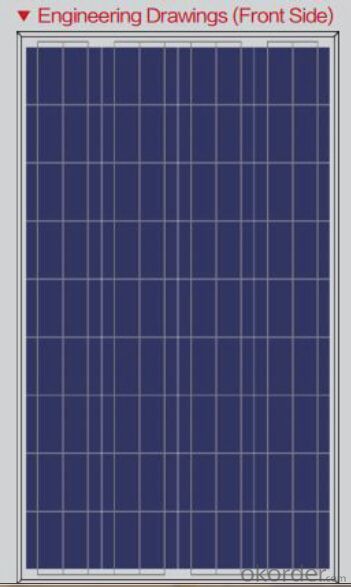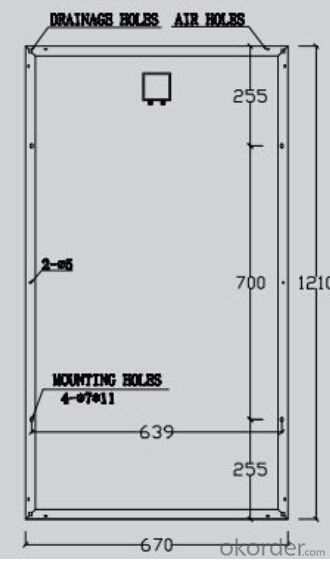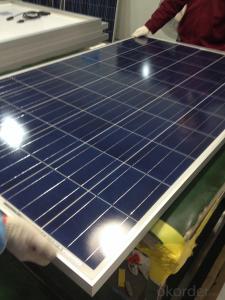Polycrystalline Solar Panels-155W-Apply to Small Solar System
- Loading Port:
- Shanghai
- Payment Terms:
- TT OR LC
- Min Order Qty:
- 10000 PCS
- Supply Capability:
- 50000000 PCS/month
OKorder Service Pledge
OKorder Financial Service
You Might Also Like
Product Description
Solar Polycrystalline Series Panels
Introduction of our company
We are internationally acclaimed enterprise which specializes in manufacturing of PV solar modules. It is part of our companies, boasting of a glorious history of over 40 years in engineering and manufacturing activities.
Headquartered in wuxi we own one of the most technologically advanced solar PV module manufacturing facilities in India. Our ISO 9001-2008 accredited manufacturing plant, located in the Special Economic Zone (SEZ) of Falta, West Bengal, is spread over a sprawling 40,000 sq ft area and boasts of a 150 MW installed production capacity.
Having built a strong foundation in the sustainable energy market and being one of the front-runners among leading solar PV module manufacturers, Our company has not only fostered innovation but has built trust, honesty and social responsibility.
Customer satisfaction is considered to be the first priority in our organization. We are known for our innovation, technology, skill and dedication.
We believes that Innovation is the key factor to success, starting with module manufacturing and then gradually expanding into system integration and providing turnkey power solution for both on and off grid applications. As a part of our expansion plan to be among the largest solar module manufacturers, we look forward to include solar cells and wafers into our manufacturing base.
Characteristics of Polycrystalline Solar Panels
I Solar Cell : High efficiency crystalline solar cell. Even if under the weak light, the solar module can produce maximum power output.
II Tempered glass (toughened glass): Anti-reflecting coating and high transmission rate glass increase the power output and mechanical strength of solar module.
III EVA and TPT: Using high quality EVA and TPT to prevent destroying and water.
IV AI frame: Without screw, corner connection. 6 holes on the frame can be installed easily.
V Junction box: Multi function junction box with water proof.
VI Long lifetime: ≥25 years; Less power decrease
VII Good performance of preventing from atrocious weather such as wind and hails.
VIII Resisting moisture and etching effectively, not effected by geology.
Standard Test Conditions of Polycrystalline Solar Panels
The opto-electrical specifications shown below are stabilized values being measured at Standard Test Conditions, Irradiance: 1000W/m2, Spectrum: AM1.5 at 25°C, The info below is subject to manufacturing tolerances. Where appropriate minutes of measurement are available and are used for the dimensioning of the installation.
Advantages of Polycrystalline Solar Panels
1.High reliability with guaranteed -3% to +5% power output tolerance, ensuring return on investment
2. High conversion efficiency based on leading innovative photovoltaic technologies
3. Withstands high wind-pressure and snow load, and extreme temperature variations
4. Attractive appearance Unique frame design, high mechanical strength, and easy Installation
Characteristics of Polycrystalline Solar Panels
Max Power Voltage Vmp (V) | 17.6V | 17.4 V |
Max Power Current Imp (A) | 6.82A | 6.33A |
Open Circuit Voltage Voc (V) | 22.6V | 22.4V |
Short Circuit Current Isc (A) | 7.26A | 6.87A |
Max Power Pm (W) | 145W | 145W |
Temperature Coefficient of Cells
NOCT | 47℃±2℃ |
Temperature Coefficients of Isc (%/℃) | 0.06 |
Temperature Coefficients of Voc (%/℃) | -0.33 |
Temperature Coefficients of Pmp (%/℃) | -0.45 |
Mechanical Data Solar Polycrystalline Series
Power | 120W/120W |
Dimension | 1219×670×30mm/1120×670×30mm |
Weight | 7.7 kg/8.4kg |
Tolerance | ±3% |
The dimension of the modules can be changed according to the demand of clients Limits.
Operating Temperature | –45 °C to +80°C |
Storage Temperature | –45 °C to +80°C |
Max System Voltage | 700V |
Guarantee Solar Polycrystalline Series Panels
Products Guarantee | 2 years free from defects in materials and workmanship |
Performance Guarantee | No less than 90% within 10yrs and no less than 80% within 25yrs |
Certificates | IEC, ISO, TUV, CE |
Dimension of Solar Polycrystalline Series Panels


FAQ
We have organized several common questions for our clients,may help you sincerely:
1. What’s price per watt?
A: It’s depends on the quantity, delivery date and payment terms of the order. We can talk further about the detail price issue. Our products is high quality with lower price level.
2. Can you tell me the parameter of your solar panels?
We have different series of cells with different power output, both from c-si to a-si. Please take our specification sheet for your reference.
3. How do you pack your products?
We have rich experience on how to pack the panels to make sure the safety on shipment when it arrives at the destination.
4. What is your warranty system?
Our product performance guarantees for 25 years
• 12 years guarantee for workmanship
• Timeliness of delivery
• Quality Products certified (TÜV, UL, CE, ISO)
5. How do you pack your products?
We have rich experience on how to pack the panels to make sure the safety on shipment when it arrives at the destination.
- Q:will at least consider them for their home electricity? I've seen several articles that new technologies are now being used, but it doesn't seem to be promoted to residential apps. I've even seen that the solar technology will be used in paints in the near future.
- Solar panels are cost effective if they are used over their payback period. The problem is that the down payment is expensive, and the payback period is maybe 0-20 years, so very few people actually expect to own their homes for 0-20 years. It also only really makes sense in areas that buy back electricity generated during the day when you're not using it. In Germany and other european countries, power companies are required to buy back electricity at a higher price than they sell it for--this reduces the payback period and is a great incentive for solar panels. For this reason, they are much more popular over there. Given a little time for the price to fall and given some change in energy policy, solar panels will become more cost effective in the future. Depends on who gets elected, though. There is a solution to the payback period problem, though. Rather than homeowners taking on the long payback period in homes they may not own long enough, some companies are buying panels and leasing them to homeowners. In exchange, homeowners get reduced electric bills, that pay off the lease payments, plus a little extra. I think this is the way to go. check out the link below.
- Q:I'm going to pitch an idead to my school about switching to Solar Energy. What are positive and negative effects of the solar panels?Also what is the cost for installing them into a highschool?How much would the electricity bill decline afterwards?
- Solar panels can convert sunlight into electricity which can be used in daily life,solar panels utilize sunrays,it doesn't discharge any polluted gas,it is environment friendly,it is also cost effective,you can make money by sell the surplus electricity to your country, On question is that solar panles have to be use in where sun is abundent.
- Q:How do solar panels affect the property's overall cost savings?
- Solar panels can have a significant positive impact on a property's overall cost savings. By harnessing sunlight to generate electricity, solar panels can reduce or even eliminate monthly electricity bills. Additionally, excess energy generated by solar panels can be sold back to the grid, providing an additional income stream. Furthermore, solar panels can increase the value of a property, making it more attractive to potential buyers. Overall, solar panels contribute to long-term cost savings by reducing reliance on traditional energy sources and providing a sustainable and cost-effective energy solution.
- Q:My house uses 500 kw a month, air conditioning is the main consumer, is it possible to install solar panels in my roof to produce this amount, and aproximate cost, thanks .
- Replace your compression driven airconditioner with a gas fired absorption cycle air conditioner (there'll be a government subsidy or grant for that due to the R22 being phased out), install vacuum tube solar thermal collectors at a tenth the price of solar photovoltaics and use the hot water for the absorption cycle heat source with the natural gas burners as a backup. This avoids all the energy losses involved in the various energy conversions and solar thermal uses all wavelengths of solar energy while many photo-voltaics uses only one wavelength (newer dye based, multi layer, and quantum dot photovoltaics are all about using more than one wavelength of light). Solar thermal will also give you hot water and residential heating which are the other two big energy uses in a home. If you are bent on spending ten times the money on photovoltaics instead of solar thermal then figure out how many hours you actually run your AC for, use the filter replacement counter on your programmable thermostat to give you how long your fan is running in days and multiply that by 24 then divide your 500 kw/hrs by this value and since the power company only buys power from you at half the price that they will sell it to you at and you will have to buy power back at night, multiply by a fudge factor of say .5, this gives you a rough estimate of how many watts of solar panels you'll need to install in kilowatts, multiply this by 0,000 and that's roughly how much it will cost you in dollars (assuming $0 per watt installed, solar cells can be as low as $ per watt to manufacture but those aren't available yet and you also need to have them assembled into panels and installed so $0 per watt is a reasonable figure, people usually use values from $4 per watt through $9 per watt). Then after you get over the sticker shock, reconsider solar thermal.
- Q:Can solar panels be installed on a shopping mall or retail center?
- Yes, solar panels can be installed on a shopping mall or retail center. In fact, many shopping malls and retail centers around the world have already incorporated solar panels into their infrastructure. This not only helps to reduce energy costs for the businesses operating within the mall but also promotes sustainability and reduces the carbon footprint of the facility.
- Q:I need to know how solar photovoltaic panels work. Anyone have a good explanation?
- Hey E Girl, photovoltiac panels are pretty simple. They start with a solid block of silicone, and shave thin layers off of them, called wafers. Once you have about 72 of them, you take half of them and dope them with boron, then the other half are doped with phosphorous. Once that's done, they take one each phosphorous and boron wafer, and glue them together with a special conductive epoxy glue, and attach a wire to each wafer. When the two glued wafers are exposed to the sun, a reaction occurs that forces free electrons from the silicone particles from one wafer onto the other, and a voltage is generated between them, about /2 volt to be exact. Once all 36 pairs are glued together, they are wired in series, connecting the phosphourous wafer from one to the boron wafer on the next, and so on. If you start with 72 wafers, you'll have 36 pairs glued together when you are done. At /2 volt each, that makes a 8 volt panel, which is used to charge a 2 volt battery. The charging source always has to have a few more volts than the battery. These 36 pairs of cells are then arranged on some kind of back board, glued down, covered with acrylic glass and mounted in a frame. There are some great websites you can go to for more info, I will list some below. Did you know that there are over 00,000 homes and businesses in the US alone that use some level of solar power to operate their electrical systems? That's good news. We actually live in one of those homes, it is powered by both the wind and sun and heated with solar and wood. I hope this answers your question, good luck, and take care, Rudydoo
- Q:I was looking at thin flexible solar panels as solar panels 500w a option to upgrade a 20w solar panel I have permanently mounted to the roof of a home made camper van.Why I was thinking flexible is at just 2mm thin they can be glued down and being flexible they will follow the contour of the rounded shape of the roof of my camper (boxy standard solar panel spoils the lines a little)Another reason is no glass to brake when traveling on dirt tracks(though I am surprised mine hasn't broken yet after thousands of km on corrugated dirt roads). Finally there is a weight saving at only /3 the weight or less then a standard glass panel.There are different grades of flex PV some of the more expensive ones are very flexible with extremely thin backing at around .5mm The ones I was looking at are cheaper and at around 2mm with a thin flexible aluminum backing.$250 is about the going rate for 20w OKorder job. Below is a pic of a smaller one 60w or so.Has anyone had any experience with them?
- but it's very interesting and I wanted to ask you. In your case this is good solution, but I saw flexible panels in OKorder much cheaper than 250$. This is the price of standard solar panel 20w. Maybe your panels with better efficiency? I know that flexible panels are less than half efficient than regular panels, thats why you need twise more area to get the same output. What is your usage of this energy in this van? I know there are many ideas of solar cars, but if this solution is efficent enough today? Thanks!
- Q:I am moving to Hawaii and the house we are living in has independent electricity. (solar panels and gas powered generators.)
- The system in the Hawaiian house has solar panels that charge a battery bank. If the sun doesn't shine enough, the generator will kick on and provide the extra power needed. An inverter converts the DC voltage stored in the batteries to AC power that you plug into a wall outlet to use. Depending on the inverter, it should be exactly the same as the AC you buy from the electric company now, so anything that you currently plug in to use will work. The exception is if they are using an inexpensive modified sine wave inverter, that doesn't generate as clean power as a pure sine wave inverter. Some delicate electronics may have trouble running on it. You may want to ask the house owners which type of inverter it is. If they don't know, ask them the model and you can easily look it up.
- Q:Can solar panels be used for powering a water treatment plant?
- Yes, solar panels can be used to power a water treatment plant. Solar energy can be harnessed to generate electricity, which can then be used to power the various processes involved in treating and purifying water. This renewable energy source provides a sustainable and environmentally friendly solution for powering water treatment plants.
- Q:What size of system would I need to get if I use on average 500 kilowatt hrs a month I would like to do a tie in grid system I live in the states south central area of States any info or links to sites would be wonderful I am interested in this type of energy soure thank you
- First find out from your electric company whether they allow grid tie systems. IF so then they can help you figure out what you need.
1. Manufacturer Overview |
|
|---|---|
| Location | |
| Year Established | |
| Annual Output Value | |
| Main Markets | |
| Company Certifications | |
2. Manufacturer Certificates |
|
|---|---|
| a) Certification Name | |
| Range | |
| Reference | |
| Validity Period | |
3. Manufacturer Capability |
|
|---|---|
| a)Trade Capacity | |
| Nearest Port | |
| Export Percentage | |
| No.of Employees in Trade Department | |
| Language Spoken: | |
| b)Factory Information | |
| Factory Size: | |
| No. of Production Lines | |
| Contract Manufacturing | |
| Product Price Range | |
Send your message to us
Polycrystalline Solar Panels-155W-Apply to Small Solar System
- Loading Port:
- Shanghai
- Payment Terms:
- TT OR LC
- Min Order Qty:
- 10000 PCS
- Supply Capability:
- 50000000 PCS/month
OKorder Service Pledge
OKorder Financial Service
Similar products
New products
Hot products
Hot Searches
Related keywords






























